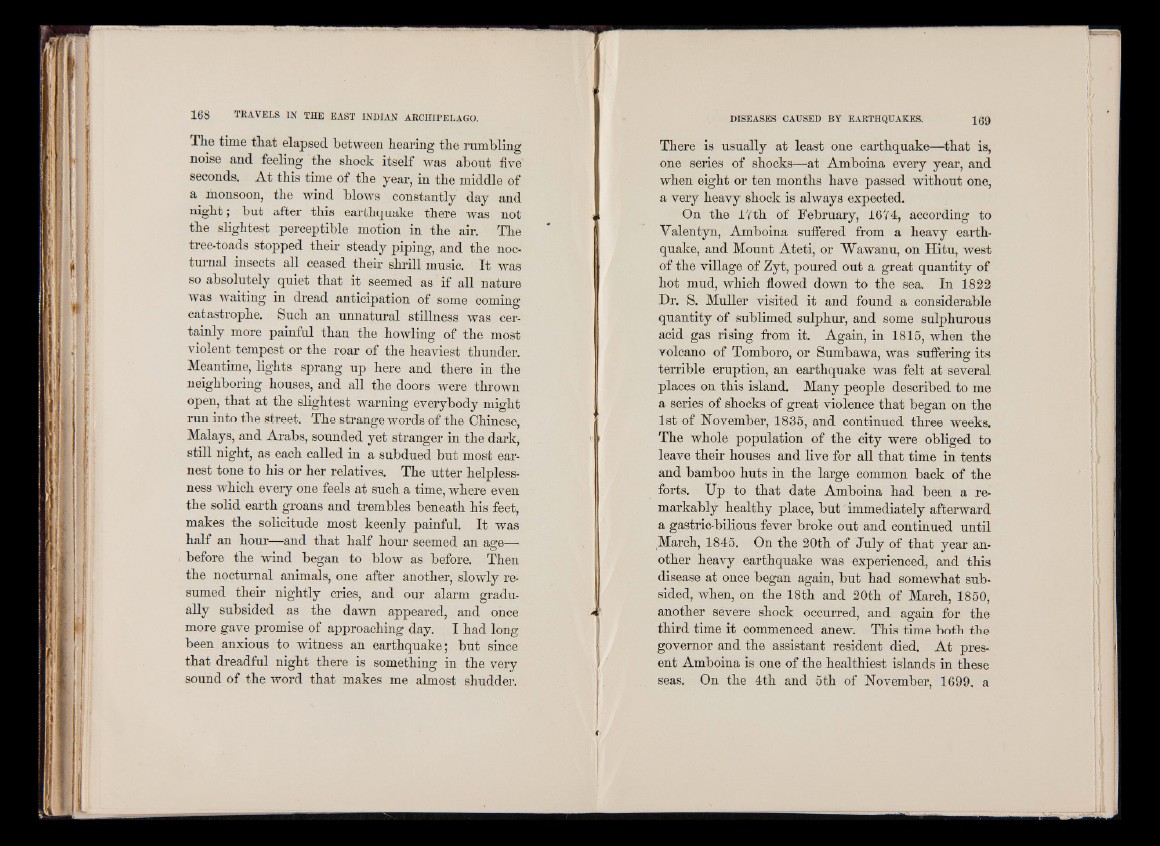
The time that elapsed between hearing the rumbling
noise and feeling the shock itself was about five
seconds. At this time of the year, in the middle of
a monsoon, the wind blows constantly day and
night; but after this earthquake there was not
the slightest perceptible motion in the air. The
tree-toads stopped their steady piping, and the nocturnal
insects all ceased their shrill music. It was
so absolutely quiet that it seemed as if all nature
was waiting in dread anticipation of some coming
catastrophe. Such an unnatural stillness was certainly
more painful than the howling of the most
violent tempest or the roar of the heaviest thunder.
Meantime, lights sprang up here and there in the
neighboring houses, and all the doors were thrown
open, that at the slightest warning everybody might
run into the street. The strange words of the Chinese,
Malays, and Arabs, sounded yet stranger in the dark,
still night, as each called in a subdued but most earnest
tone to his or her relatives. The utter helplessness
which every one feels at such a time, where even
the solid earth groans and trembles beneath his feet,
makes the solicitude most keenly painful. It was
half an hour—and that half hour seemed an agre—
before the wind began to blow as before. Then
the nocturnal animals, one after another, slowly resumed
their nightly cries, and our alarm gradually
subsided as the dawn appeared, and once
more gave promise of approaching day. I had long
been anxious to witness an earthquake; but since
that dreadful night there is something in the very
sound of the word that makes me almost shudder.
There is usually at least one earthquake—that is,
one series of shocks—at Amboina every year, and
when eight or ten months have passed without one,
a very heavy shock is always expected.
On the 17th of February, 1674, according to
Valentyn, Amboina suffered from a heavy earthquake,
and Mount Ateti, or Wawanu, on Hitu, west
of the village of Zyt, poured out a great quantity of
hot mud, which flowed down to the sea. In 1822
Dr. S. Muller visited it and found a considerable
quantity of sublimed sulphur, and some sulphurous
acid gas rising from it. Again, in 1815, when the
volcano of Tomboro, or Sumbawa, was suffering its
terrible eruption, an earthquake was felt at several
places on this island. Many people described to me
a series of shocks of great violence that began on the
1st of November, 1835, and continued three weeks.
The whole population of the city were obliged to
leave their houses and live for all that time in tents
and bamboo huts in the large common back of the
forts. Up to that date Amboina had been a remarkably
healthy place, but immediately afterward
a gastric-bilious fever broke out and continued until
March, 1845. On the 20th of July of that year another
heavy earthquake was experienced, and this
disease at once began again, but had somewhat subsided,
when, on the 18th and 20th of March, 1850,
another severe shock occurred, and again for the
third time it commenced anew. This time both the
governor and the assistant resident died. At present
Amboina is one of the healthiest islands in these
seas. On the 4th and 5th of November, 1.699, a